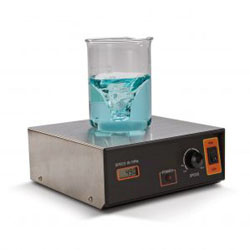Magnetic Stirrer with Auto Reverse and Timer Control
In labs and scientific studies, being exact, precise, and fast is really important. One tool that helps a lot is the magnetic stirrer. It's used to mix liquids in a careful way. To make lab work even smoother, magnetic stirrers now come with cool features like auto reverse and timer control. This article talks about why these features are useful and how they make lab work better.
Mixing Better with Auto Reverse:
Regular magnetic stirrers spin in one direction, making a one-way stirring motion. But some experiments need the mixing to go back and forth for the best results. Magnetic stirrers with auto reverse can do this automatically. They change the spin direction at certain times, making sure the mixing is really good.
Here are the good things about auto reverse:
Better Mixing: Auto reverse stops uneven mixing, making sure everything is mixed well. This is really useful for samples that can separate or settle.
Faster Dissolving: For experiments where solids need to dissolve or mix with liquids, going back and forth speeds up the process. Auto reverse helps dissolve things quickly, saving time in experiments.
No Build-up: Some thick liquids or mixtures stick to the stirring bar and stop it from working well. Auto reverse stops this by changing the spin, so there's no build-up, and stirring can keep going smoothly.
Precise Time Control for Better Experiments:
Another cool thing in modern magnetic stirrers is timer control. It lets you set how long the stirrer should work. This helps in a few ways:
Same Experiments Every Time: With a timer, scientists can do experiments the same way every time. This makes it easy to compare different experiments and trust the results.
No Need to Watch All the Time: Using a timer means scientists don't have to keep watching the stirrer. They can set it and focus on other important things. This helps avoid mistakes and makes results reliable.
Work Smarter: Setting the stirrer to stop by itself saves time. Scientists can do other tasks or run other experiments while the stirrer works. This makes the lab more efficient and saves time.
No Over-Mixing: Some experiments need just the right amount of mixing. The timer lets scientists control how long the stirrer works, so they get the right mixing without ruining the sample.
Conclusion:
Having auto reverse and timer control in magnetic stirrers is a big step forward in lab tools. These features help scientists mix things evenly, dissolve stuff faster, and avoid problems like build-up. The timer control makes experiments consistent, hands-free, and more efficient. Magnetic stirrers with auto reverse and timer control are a smart choice for labs that want accurate results, better productivity, and smoother lab work.

Comments
Post a Comment